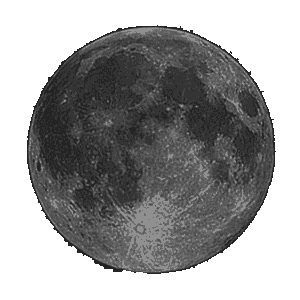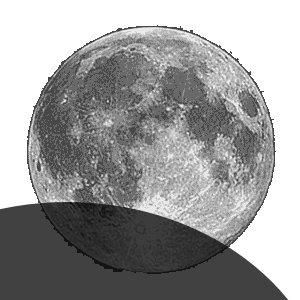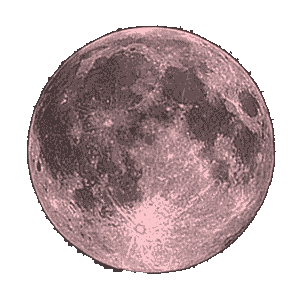Lunar Eclipses 2020 to 2045
Skip to calendarLunar Eclipse Types
There are three main types of eclipses of the moon, all are the result of the Earth casting a shadow across all or part of the full moon. However, not all eclipses are equal, and this depends on both how much and what part of the Earth's shadow is cast across the moon. The cause of the eclipse is always the same though; when the Sun, Earth and Moon are in alignment.
Penumbral Eclipse

Probably the least impressive kind of lunar eclipse this is where the outer part of the earth's shadow (the penumbra) covers the moon. The overall effect is somewhat subtle, and if you don't know it is in progress you may well miss it.
Partial Eclipse

As the name suggests a partial lunar eclipse occurs when only part of the moon's face is thrown into shadow. Unlike the penumbral eclipse the noticeable part of the shadow is formed by the umbra - the central part of the Earth's shadow. As partial eclipses proceed you will see the shadow growing across the face of the Moon before receding. How much of the Moon the shadow covers depends on the magnitude of the eclipse.
Total Eclipse

When a perfect alignment of the Sun, Earth and Moon occurs the conditions for a total lunar eclipse are set. In these most impressive eclipses the moon is completely covered by the central part of the Earth's shadow (the umbra). Not only does the whole Moon become darker as the shadow creeps across its face but it takes on an orange or red hue. For this reason this event is also knowns as a Blood Moon, not that there is anything sinister about it - it's just the Sun's light being diffused and flitered through Earth's atmosphere that causes the red tint.
Lunar Eclipse Calendar
| Jan | Feb | Mar | Apr | May | Jun | Jul | Aug | Sep | Oct | Nov | Dec | |
|---|---|---|---|---|---|---|---|---|---|---|---|---|
| 2020 |
 5th Jun
5th Jun
|
 5th Jul
5th Jul
|
 30th Nov
30th Nov
|
|||||||||
| 2021 |
 26th May
26th May
|
 19th Nov
19th Nov
|
||||||||||
| 2022 |
 16th May
16th May
|
 8th Nov
8th Nov
|
||||||||||
| 2023 |
 5th May
5th May
|
 28th Oct
28th Oct
|
||||||||||
| 2024 |
 25th Mar
25th Mar
|
 18th Sep
18th Sep
|
||||||||||
| 2025 |
 14th Mar
14th Mar
|
 7th Sep
7th Sep
|
||||||||||
| 2026 |
 3rd Mar
3rd Mar
|
 28th Aug
28th Aug
|
||||||||||
| 2027 |
 20th Feb
20th Feb
|
 18th Jul
18th Jul
|
 17th Aug
17th Aug
|
|||||||||
| 2028 |
 12th Jan
12th Jan
|
 6th Jul
6th Jul
|
 31st Dec
31st Dec
|
|||||||||
| 2029 |
 26th Jun
26th Jun
|
 20th Dec
20th Dec
|
||||||||||
| 2030 |
 15th Jun
15th Jun
|
 9th Dec
9th Dec
|
||||||||||
| 2031 |
 7th May
7th May
|
 5th Jun
5th Jun
|
 30th Oct
30th Oct
|
|||||||||
| 2032 |
 25th Apr
25th Apr
|
 18th Oct
18th Oct
|
||||||||||
| 2033 |
 14th Apr
14th Apr
|
 8th Oct
8th Oct
|
||||||||||
| 2034 |
 3rd Apr
3rd Apr
|
 28th Sep
28th Sep
|
||||||||||
| 2035 |
 22nd Feb
22nd Feb
|
 19th Aug
19th Aug
|
||||||||||
| 2036 |
 11th Feb
11th Feb
|
 7th Aug
7th Aug
|
||||||||||
| 2037 |
 31st Jan
31st Jan
|
 27th Jul
27th Jul
|
||||||||||
| 2038 |
 21st Jan
21st Jan
|
 17th Jun
17th Jun
|
 16th Jul
16th Jul
|
 11th Dec
11th Dec
|
||||||||
| 2039 |
 6th Jun
6th Jun
|
 30th Nov
30th Nov
|
||||||||||
| 2040 |
 26th May
26th May
|
 18th Nov
18th Nov
|
||||||||||
| 2041 |
 16th May
16th May
|
 8th Nov
8th Nov
|
||||||||||
| 2042 |
 5th Apr
5th Apr
|
 29th Sep
29th Sep
|
||||||||||
| 2043 |
 25th Mar
25th Mar
|
 19th Sep
19th Sep
|
||||||||||
| 2044 |
 13th Mar
13th Mar
|
 7th Sep
7th Sep
|
||||||||||
| 2045 |
 3rd Mar
3rd Mar
|
 27th Aug
27th Aug
|